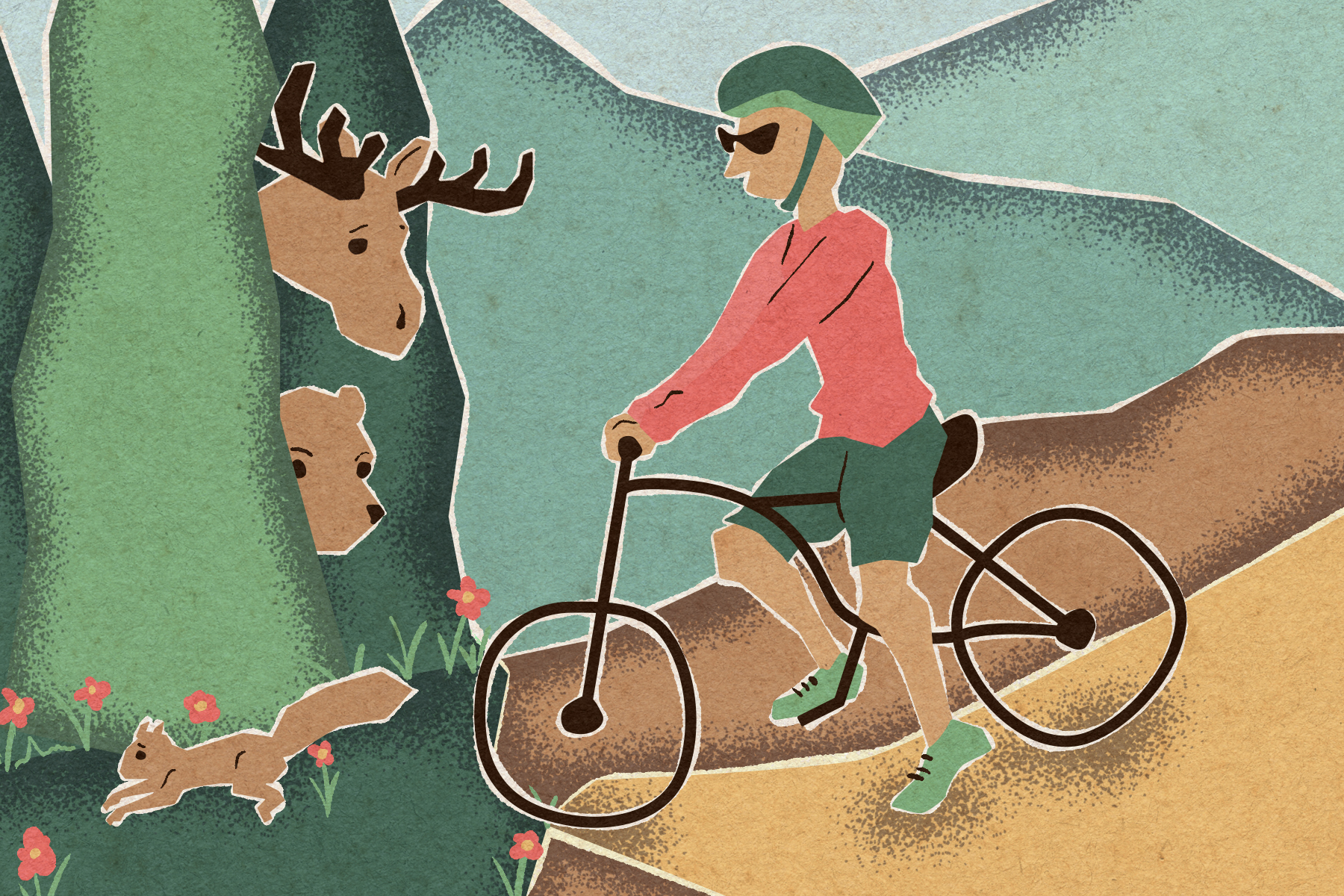Any mountain biker, hiker, skier or snowboarder has heard the phrases “hammer the uphill,” “shred the gnar” and “rail a turn” more times than they can count. Whether accepted or scorned, this terminology is part of the essence of adventure sport culture, and these words are the chosen descriptors of formative experiences for thousands, maybe millions, of athletes. Each phrase is rich with connotation, recalling images of pedals striking against rock-rolls, dust kicked up on sharp turns or tires cutting through loam. In mountain biking, these are each small instances of joy on the trail.
When inspected for their literal meaning, however, these words are, at their core, violent. Their brutality — shred, hammer, rail — underscores the destructiveness of the activities they describe and highlights the adversarial relationship a mountain biker, hiker or winter athlete has with their surroundings. This violence is directly tied to the relationship built between a trail user and the land they occupy and is one of many reasons for the relative lack of BIPOC (Black, Indigenous and people of color) participation in outdoors sports.
The Trail’s Effect
The trail attracts users for a variety of reasons. The main one is often the sense of accomplishment and enjoyment many derive from time spent outdoors. Those who engage in outdoor activity are seen to be more fulfilled and are perceived as leading more enjoyable lives than those who do not. When considering the true source of this enjoyment, however, one realizes that for many, the act of cresting a hill, bombing a descent or tearing up a turn is itself the “prize” of being in nature. The accomplishment of dominating nature is directly linked to the fulfillment of being outside. In other words, the source of enjoyment is the perception of conquering nature.
When understood through the lens of the violence it encourages, the trail can be seen as a hugely powerful source of othering. It is designed to separate the trail user from the environment they subconsciously enjoy destroying. The clear distinction between wilderness and trail buffers the cyclist or hiker from the reality of nature, giving them an enclave where the danger of the wilderness is repressed. Through carefully placed rocks, cut trees and groomed dirt paths, the trail and the trail user are obviously separated from the wilderness. In partitioning an outdoor adventurer from that which they are simultaneously viewing and destroying, the trail appropriates the broader power to separate the trail user not just from nature, but from other entities as well.
Mountain biking’s obsession with shredding, railing and hammering is possible only when realized through a contract between a rider and a well-kept trail. By separating nature from trail and cyclist from dirt, the trail lets violence flow toward the land but never back to the rider. This relationship not only exists between the mountain biker and the land they ride upon but between any two entities on a trail — more specifically, one outdoor enthusiast and another. When any trail user is given the prerogative to stand apart from and destroy nature, they are simultaneously imbued with the power to alienate and harm another trail user. By enabling violence against the land, the trail offers the parallel possibility of aggression against people and communities found in or around the land that a trail’s violence bisects.
Whiteness in Mountain Biking
Those familiar with the outdoors, and many who are not, are acutely aware of the blinding whiteness of outdoor spaces. Boulder County, often viewed as one of the most active hubs of outdoor activity in the United States, is (astonishingly, but unsurprisingly) 90% non-Hispanic Caucasian. Similarly, as of 2016, readers of “Singletrack Magazine” — a mountain biking publication — were also 90% Caucasian. There are dozens of articles detailing the “unbearable whiteness” of a variety of outdoor sports and there is a treasure trove of anecdotal knowledge on social media that displays the ostracization many individuals from minority groups feel in the outdoors. The expensive nature of gear-based hobbies and the gatekeeping of current outdoor recreationists can be huge barriers to BIPOC participation; however, there is also a connection to be drawn between the whiteness of the outdoors, the nature of the trail and the terminology used to describe adventure sports.
The fetishization of colonialism and violence is not unfamiliar to white American culture. In fact, it is nearly ingrained in what it means to be white in America. From obsession with the ownership of Black bodies to perpetual violence against women, for white America, there seems to be an undying need to enact violence against some entity without retribution. The trail is only another place for this fetish to be reenacted. Maybe this is why the outdoors are so white — the underlying knowledge that on the trail, violence once channeled toward marginalized people is now being directed towards marginalized places. The sense that in these places, a mountain biker, climber or hiker who once was the recipient of harm may once again become a target for ridicule or condescension.
Those who were once subject to the wanton violence of colonialism recognize the similarities between violence against land and people. The trail’s enabling of this power to shred, rail, hammer and tear the land enables a similar shredding, railing and hammering of the people who occupy it, and if those people understand themselves as the recipients of violence rather than purveyors of it, they will undoubtedly be wary of the trail.
Nature is alluring. The freedom of speed in the mountains, whether found on foot, two wheels or skis, is intoxicating and draws people of all backgrounds into the woods, desert and snow. Despite this, the language surrounding the feeling of euphoria that is so connected to the outdoors does not reflect beauty or bliss, but destruction. The disconnect between the experience of being outdoors and the set of words given to describe it is as startling as it is alienating. Although it is ingrained in adventure recreation culture, any opportunity to recontextualize or change the brutality of the current mountain biking vernacular will be valuable in the reframing of outdoor sports to reflect the enjoyment of existing within a beautiful environment, rather than revelry in destruction. The trail separates, but this separation can be used to encourage connection with land while free from harm rather than destruction of land while free of consequences.


















This is the most bizarre pseudo-enlightened trash I have read in a long time. Congratulations 👏